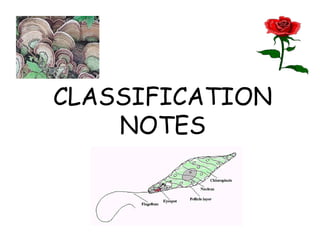Classification part 1 for blog
•Als PPT, PDF herunterladen•
2 gefällt mir•2,488 views
Melden
Teilen
Melden
Teilen

Empfohlen
Weitere ähnliche Inhalte
Was ist angesagt?
Was ist angesagt? (20)
Power point presentation on topic Classification -Arunima V.S

Power point presentation on topic Classification -Arunima V.S
Ähnlich wie Classification part 1 for blog
Ähnlich wie Classification part 1 for blog (20)
Less.2.how are living things similar and different

Less.2.how are living things similar and different
Mehr von wja10255
Mehr von wja10255 (20)
Unit 6 ch 14 s3 land management & conservation

Unit 6 ch 14 s3 land management & conservation
Unit 4 ch 17 s1 energy resources & fossil fuels

Unit 4 ch 17 s1 energy resources & fossil fuels
Unit 3 a ch 8 s2 how species interact with each other

Unit 3 a ch 8 s2 how species interact with each other
Unit 2 a ch 4 s1 ecosystems- everything is connected

Unit 2 a ch 4 s1 ecosystems- everything is connected
Kürzlich hochgeladen
Kürzlich hochgeladen (20)
Strategies for Landing an Oracle DBA Job as a Fresher

Strategies for Landing an Oracle DBA Job as a Fresher
Polkadot JAM Slides - Token2049 - By Dr. Gavin Wood

Polkadot JAM Slides - Token2049 - By Dr. Gavin Wood
Apidays Singapore 2024 - Scalable LLM APIs for AI and Generative AI Applicati...

Apidays Singapore 2024 - Scalable LLM APIs for AI and Generative AI Applicati...
Web Form Automation for Bonterra Impact Management (fka Social Solutions Apri...

Web Form Automation for Bonterra Impact Management (fka Social Solutions Apri...
Axa Assurance Maroc - Insurer Innovation Award 2024

Axa Assurance Maroc - Insurer Innovation Award 2024
Strategize a Smooth Tenant-to-tenant Migration and Copilot Takeoff

Strategize a Smooth Tenant-to-tenant Migration and Copilot Takeoff
Apidays New York 2024 - The value of a flexible API Management solution for O...

Apidays New York 2024 - The value of a flexible API Management solution for O...
Boost Fertility New Invention Ups Success Rates.pdf

Boost Fertility New Invention Ups Success Rates.pdf
TrustArc Webinar - Stay Ahead of US State Data Privacy Law Developments

TrustArc Webinar - Stay Ahead of US State Data Privacy Law Developments
ICT role in 21st century education and its challenges

ICT role in 21st century education and its challenges
Cloud Frontiers: A Deep Dive into Serverless Spatial Data and FME

Cloud Frontiers: A Deep Dive into Serverless Spatial Data and FME
Strategies for Unlocking Knowledge Management in Microsoft 365 in the Copilot...

Strategies for Unlocking Knowledge Management in Microsoft 365 in the Copilot...
Connector Corner: Accelerate revenue generation using UiPath API-centric busi...

Connector Corner: Accelerate revenue generation using UiPath API-centric busi...
"I see eyes in my soup": How Delivery Hero implemented the safety system for ...

"I see eyes in my soup": How Delivery Hero implemented the safety system for ...
A Beginners Guide to Building a RAG App Using Open Source Milvus

A Beginners Guide to Building a RAG App Using Open Source Milvus
Mastering MySQL Database Architecture: Deep Dive into MySQL Shell and MySQL R...

Mastering MySQL Database Architecture: Deep Dive into MySQL Shell and MySQL R...
Classification part 1 for blog
- 1. CLASSIFICATION NOTES
- 2. Classification- A grouping of objects or information based on similarities Taxonomy- the branch of biology concerned with the grouping & naming of organisms
- 3. Aristotle:384-322 BC First method of classification 2 major groups Plants - size & structure Animals - where they lived (land or water)
- 4. Linnaeus: 1707 - 1778 Still used today Based on physical characteristics, close relationships 7 Levels of classification 1. Kingdom 2. Phylum 3. Class 4. Order 5. Family 6. Genus 7. Species
- 5. King Phillip Came Over From Great Scotland
- 6. Taxon: a group at any level of organization.
- 7. Figure 18-5 Classification of Ursus arctos Section 18-1 Polar bear Black bear Giant Red fox Abert Coral Sea star panda squirrel snake KINGDOM Animalia PHYLUM Chordata CLASS Mammalia ORDER Carnivora FAMILY Ursidae GENUS Ursus SPECIES Ursus arctos Go to Section:
- 8. Binomial nomenclature: System that gives each organism 2 names Genus: 1st word, always capitalized. Group of closely related species species: 2nd word, lowercase. descriptive (latinized) Ex-Eurycea bislineata-2 line salamander common name varies from place to place
- 9. • http://www.search.com/reference/Wile_E._ Coyote_and_Road_Runner
- 10. Domain Archaea Kingdom Archaebacteria Prokaryotes - No nucleus or membrane- bound organelles Cell walls without peptidoglycan Unicellular Autotroph or heterotroph Examples: Methanogens, Halophiles
- 11. Domain Bacteria Kingdom Eubacteria Prokaryotes Cell walls with peptidoglycan No nucleus or membrane bound Organelles Unicellular Autotroph or Heterotroph E. Coli and Streptococcus
- 12. Domain Eukarya Kingdom Protista Eukaryotic Cell walls in SOME (plantlike) with cellulose with chloroplasts Most are Unicellular some Multicellular Autotroph or heterotroph Paramecium, Kelp, Euglena
- 13. Domain Eukarya Kingdom Fungi Eukaryote Cell wall with chitin, nucleus and membrane-bound organelles-no chloroplasts Most are multicellular Heterotroph Eats by absorbing nutrients Mushrooms, yeasts
- 14. Domain Eukarya Kingdom Plantae Eukaryotes Cell walls with cellulose, have chloroplasts Multicellular Autotroph Mosses, ferns, trees, flowering plants
- 15. Domain Eukarya Kingdom Animalia Eukaryote No cell wall or chloroplasts Have specialized systems Multicellular Heterotroph sponges, worms, insects, fish
- 16. • This kingdom contains all autotrophic organisms. • The term autotrophic refers to… • The opposite of autotrophic is… • These organisms contain the material chitin… • These kingdoms contain prokaryotic cells…
- 17. • Which is the most general of Linnaeus’ seven taxa? • If 2 organisms are in the same kingdom, must they belong to the same phylum? • If several organisms contain the same class characteristics, must they belong to the same phylum? • Linnaeus’ 2 name system is called…
- 18. • The most specific part of a scientific name is the… • If 2 organisms belong to the same order, must they belong to the same family? • In the scientific name the first letter of the ___ must be capitalized. • The scientific name must be ____ or italicized.